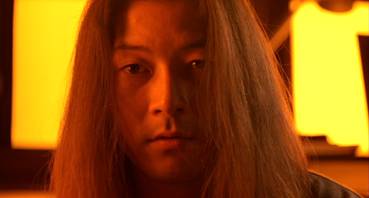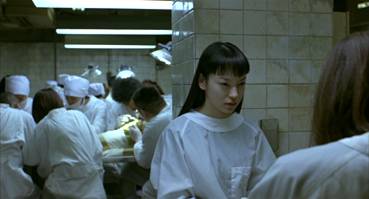|
Those
coming to Tsukamoto Shinya's Vital with
only the experience of his early films to prepare them
may be in for something of a surprise. The opening microscopic
close-ups and industrial audio-visual assault aside,
the tone here is considerably more sedate than in the Tetsuo films or the electrifying urban nightmares
of Bullet Ballet and Tokyo Fist.
It has been suggested that this is indicative of the director
reaching middle age, the raw energy of youth giving way
to experience and reflection. It's a fair enough conclusion,
evidence for which you'll find not just in the film's technical handling
but also its thematic concerns. Although Tsukamoto has returned
to a favourite topic of the destruction of the human body,
he has approached it from an almost spiritual angle, his
interest here being less in the flesh than in the nature
of human consciousness.
The
story set-up, however, does suggest that Tsukamoto is not yet ready
to play safe. Medical student Hiroshi wakes up in hospital
with no memory of how he got there, or of the details of
his life up to this moment. Returning home with his parents,
he learns that he was in a car crash that was
the fault of another and that took the life of his girlfriend
Ryoko, whom he also cannot remember. The discovery of a
medical book prompts him to recall small details of his past, and he elects
to return to his studies and re-enrols in medical school.
Three years into the course he begins his first dissection
class, and in a dark turn of fate, the body he has been
given to work on proves to be that of his deceased girlfriend.

If
it sounds like I've given a large chunk of plot away here,
you should know that I've only outlined the first thirteen minutes of the film. The economy with which
the story is set up is extraordinary,
especially given that this thirteen minutes also introduces us to fellow
student Ikumi, establishes her as the star pupil and Hiroshi
as almost her educational equal, connects and disconnects
her romantically to one of the professors (who then kills
himself), and suggests the potential for a relationship between
her and Hiroshi, all with little in the way of expository
dialogue. Time moves forward in disarming hops – in one example Hiroshi
discovers and becomes fascinated by the above-mentioned book, then
in a single edit is already enrolled in medical school. The
first three years pass in less than a minute and include
a crucial sequence in which professors repeatedly ponder
on the physical location of human consciousness.
Hiroshi's
real journey begins with the dissection classes. As he slowly
dissects Ryoko's body, her constituent parts recorded in
increasingly complex detail in a series of da Vinci-like
anatomical drawings,* he begins to have what at first seem to be flashbacks of his time with her, a relationship whose
sexual element appears to have been built around mutual erotic
asphyxiation, the extremes of life felt only through brushes
with death. The memories are first triggered when he encounters Ikumi,
who having become distressed at her inability to cope with the dissection
classes is attempting self-strangulation. It's an act that leads
the two of them into a relationship in which partial asphixiation stands
in for sex, and once even prompts a desperate response from
Ikumi when her strangulation of Hiroshi is not returned
in kind. This has direct echoes throughout Tsukamoto's work,
from the sadomasochistic aspect of relationships in Tokyo
Fist and Bullet Ballet to the
violent encounter between Yukio and his doppelganger in Sôseiji.
This is the Tsukamoto film to which Vital bears the strongest stylistic similarities, in its pacing, its mixture of carefully
composed static shots and more frenetic handheld work, and in its widescreen framing and use of colour filtration.
The fractured relationship triangle central to Tokyo
Fist, Bullet Ballet and A
Snake of June is also present here but somewhat abstracted,
with Ikumi fighting for Hiroshi's attention
against the spiritual traces of Ryoko, with which Hiroshi
becomes increasingly obsessed.

It
is this element that dips the drama into the realms of horror
fantasy, as what at first seem to be memories increasingly
appear to have spiritual existence, at least from
Hiroshi's viewpoint. Despite occasional temporal uncertainty,
Hiroshi's later conversations with Ryoko are clearly not
recollections of happier times but are taking place in the here
and now – she talks of her regret at having died and he of staying with her rather than returning to the real
(conscious) world. The two paths become increasingly diverse,
with the constant rain and grim décor of Hiroshi's
apartment and dissection classes contrasted starkly with
the sun-drenched Okinawa beach where he meets with Ryoko.
While her body is slowly dismantled in the industrial gloom
of the hospital, her spirit runs and dances freely in nature.
As he investigates the interior of her body in the smallest
detail and shares time with her in the Okinawa sunshine,
he gets to know her far better in death than he ever did
in life.
The
Japanese way of death is an important component of the film
and its storytelling, especially in the curious but touchingly
respectful ritual associated with finally laying the dissected
bodies to rest, which in the context of the story here feels
as sad a goodbye as any you'll find in even the best of
recent mainstream cinema. But just as affectingly handled
is Hiroshi's relationship with Ryoko's parents, who some years
after their daughter's death have still, thanks to her deathbed
decision to leave her body to science,** not been able to
bury her, a ritual of considerable importance to the Japanese.
Initially blaming Hiroshi for the accident and furious for bringing
them the news that he is dissecting what he at this point only suspects
is her body, they eventually encourage his visits and the
memories of their daughter that he shares with them. Later it is Ryoko's
father alone who seems able to accept Hiroshi's belief that
his encounters with Ryoko are not memories but very real experiences,
creating a bond between the two that is as close as any
Hiroshi now has to a living person. It
is through this relationship, and the one that Hiroshi rediscovers
with Ryoko, that the film is able to most effectively explore
the processes of personal grief and coming to terms with
traumatic loss.
Vital always looks and sounds gorgeous, with Tsukamoto regular Ishikawa Chu's atmospheric score and the director's own super-smart
editing and compositional camerawork contributing hugely
to a story that is told in almost purely cinematic terms.
Asano Tadanobu, one of the most successful and enigmatic
stars of modern Japanese cinema, is quietly superb as Hiroshi,
while once again female leads are compellingly played, with
Kiki (another of Tsukamoto's single name actresses) displaying
a vulnerable cool as Ikumi, and professional ballet dancer
Tsukamoto Nami (no relation) playing Ryoko with a finely
balanced combination of strength, sensitivity and vitality.
Even the smaller roles – Kishibe Ittoku as pathology professor
Dr. Kashiwabuchi, Kuminura Jun as Ryoko's father – are played
with impressive naturalism.

Despite
the film's deceptively unhurried pace, Tsukamoto packs in
a wealth of subtextual storytelling into even the smallest
details – the photo of Ikumi on the shrine in her parents'
house, for example, is not the traditional happy portrait,
but one of mournful sadness, reflecting perhaps a girl caught
between two worlds, parted from this one but denied access to the next by her
lack of burial rites. And considering the film's
grisly subject matter and potential for shock value (especially
given the explicit body horror of Tsukamoto's earlier films),
there is a restraint shown here that is both surprising
and appropriate to the ultimately optimistic thrust of the
story. The body may be destroyed, but in the process it
opens a path to the discovery of the soul.
The
two DVDs under comparison here are the Tartan UK region
2 PAL single disc and the Happinet Japanese region 2 NTSC 2-disc special
edition. It should be noted that the Happinet release features
English subtitles for the main feature only, which for
most UK viewers will render most of the extra features
at least partially bemusing. I've had the Japanese DVD for
about six months now and have held off on a review in the
hope that a UK or US release would be announced. When it
was I had somehow convinced myself that the UK version would
be considerably inferior to the Japanese release. Well shame
on me. The news, happily, is very good.
Both
discs sport what appears to be the very same anamorphic
1.78:1 transfer, though obviously the Japanese Happinet
disc is NTSC and the UK Tartan disc is PAL. Colour, sharpness,
contrast and black levels are all excellent on both releases,
and yes, the Tartan disc has a true PAL transfer.
The
audio options are also identical on both discs, with Japanese
stereo 2.0, 5.1 surround and DTS surround. The stereo track
is decent enough, but the 5.1 and especially DTS tracks
are the only way to go, having a very strong dynamic range
and making great use of the surrounds and LFE channel, especially
during Tsukamoto's trademark industrial rumbles and a startling
moment when Hiroshi, standing in the street, aurally recalls
his car crash.
It
should be noted that you cannot switch between audio tracks
on the fly on the Tartan disc – this can only be done on the Setup
menu.
Again I was expecting only minor extras on the UK release
and again I was to be proved happily wrong. The Japanese
Happinet 2-disc edition is very well featured, but Tartan
have done well by licensing many of the best features from
that set for inclusion on their own release, with the additional
bonus that on Tartan's disc they have optional English subtitles.
Japanese 2-disc Special Edition (Happinet)
On
disc 1 there are three extra features, the most notable
one being an Audio Commentary with director Tsukamoto Shinya and Kojima Hideo, the man
behind the legendary Metal Gear Solid video games
and someone Tsukamoto is clearly friends with and whose work he admires. There's a fair amount of discussion here about
what is happening on screen, but Tsukamoto supplies some
interesting background on the preparation for the shoot (attending
real autopsies, discussions with pathologists), the structure
and look of particular scenes, and how he planned specific
shots. His desire for a level of realism led to him asking
a real pathologist to write the introductory speech given
to the students at the start of their first dissection class.
He also, tellingly, admits that he knew he was breaking
a taboo, and says that "I mustn't do it, so I must
do it." It is unfortunate that this feature is not
subtitled in English, as it would certainly be of considerable
interest to all Tsukamoto fans.
Trailers
and TV Spots has the Teaser Trailer (0:59), the Theatrical Trailer (1:38) and a TV Spot (0:18). The
theatrical trailer is very similar in structure to the teaser,
though includes more footage and really plays on the inclusion
of the song Bluebird by Cocco.
Finally on disc 1 there is Staff & Cast,
which has short biographies for Tsukamoto Shinya, Cocco,
Oda Takashi, Asano Tadanobu, Tsukamoto Nami and Kiki, all
in Japanese only, I'm afraid.
Disc
2 has to be the most unusual-looking DVD I have in my collection,
being completely transparent, save for a couple of translucent
graphics, and at first glance looks like one of those protective
plastic discs that you find at the top of a CD stack. The
extra features are divided into five sections, some of which
have subdivisions.

In Production we have Starting
'Vital' (11:06), which is essentially an interview
with Tsukamoto (in one of the dingiest corners the camera
operator could presumably find) in which he talks about
the visual similarity between the microscopic world and
images of outer space and how this led to him writing Vital (or as he first called it 'Dissection Project'), as well as
issues of life and death, his own fascination with bodies
and dissection, the casting of Asano in a role he might
once have taken himself, and his plans for future film themes.
Making
'Vital' (10:27) is built around an interview
with Oda Hisashi, the man responsible for creating all of
the fake body parts for the autopsy scenes and head of the
film's 'body modelling' crew. He talks about the process
of creating these key props and their relationship to real
bodies and dissections he observed in the course of research,
which is cut with footage of the casting and building of
the fake corpses and their constituent parts. For anyone
not involved in this very specialised area of the industry,
this is fascinating viewing.
Playing
in 'Vital' (18:46) combines an edited-down
video diary of the shoot in Okinawa with an interview with
Tsukamoto in the same dark corner as the Starting 'Vital' featurette. This is an essential inclusion for the
footage of Tsukamoto at work and the chance to see the actors
on sets and locations before the film has been colour timed and
the soundtrack mixed. A large proportion of the footage is of the
hospital dissection class location, which is actually a real hospital
and the one in which Asano Tadanobu was (co-incidentally)
born. There are also a couple of nice offbeat moments, not
least Asano's 30th birthday party, and the opening walk through
greenery along a little known path and down to a deserted
beach to scout the location REALLY brought back some memories
for me (as it would for my then director, eh Camus?)
The
second section, Hiroshi's Sketch,
is a gallery of the sketches made by Hiroshi in the film
(which are fabulous), plus a few film stills of the character.
It would be nice to see the real artist (Kumazawa-san from
the film's 'body modelling' crew) credited here.
Distribution has two subsections, 'Vital' in Venice (10:47), also
an edited down video diary of the director and three stars
at the Venice film festival. Tsukamoto expresses his love
for Venice and calls Italy his second home (Happinet's Snake
of June disc also contained footage of the director
at the Venice Film Festival), all participate in photo shoots,
the girls take tourist pictures and Asano looks effortlessly
cool throughout. Festival director Marco Muller turns out
to be a huge Tsukamoto fan and even has images from Vital as wallpaper on his mobile phone. It's rather nice that
Tsukamoto gets cheered before the screening. A very engaging
inclusion.
'Vital'
in Tokyo (2:48) has Tsukamoto and his three
stars doing a brief Q&A after a screening at K's cinema
in the Shinjuku district of Tokyo (possibly the liveliest
area in the city, in case you ever get to visit). This is
of interest, but supplies little that is not covered in
more detail elsewhere.
The
third section, Gallery, also has
two subsections. Ad & Publicity Materials is exactly what you'd expect, while Products includes 3 Vital T-shirts that are not
quite as cool as they sound.
Finally
we have an audio recording of Bluebird by Cocco (6:20), the song used over the film's closing credits.
UK single disc edition (Tartan)
Although
many of the Happinet extras have been ported over to this
Tartan release, it is, somewhat disappointingly, missing
the Tsukamoto/Kojima commentary, though in its place we
do have a Commentary by Midnight
Eye's Tom Mes, whose recent book Iron Man: The Cinema
of Shinya Tsukamoto makes him probably the foremost
Western writer on the director's work. Although 'expert'
commentaries can be a little dry, especially when compared
to those by the filmmakers themselves, Mes not only knows
his Tsukamoto, he was on set for part of the shoot, enabling
him mix the analytical with the anecdotal to often engaging
effect. As an avid fan of the both Tsukamoto's films and
Japan and its culture, much of the information delivered
on the film and its cultural references were not new to
me, but it is enjoyably presented and many will find it
both both interesting and enlightening.

With
the Music Video (6:23) for Cocco's Bluebird, Tartan have the edge over Happinet, who
only have this as an audio track. Not that this matters
much – the merits of the song are very much a matter of
taste and the video consists of a largely uninspiring montage
of extracts from the film.
Venice
Premiere Footage (10:45) is exactly the same
featurette that can be found on the Happinet disc as 'Vital'
in Venice, but with the bonus of English subtitles
for dialogue and the on-screen (Japanese) titles.
The Shinya Tsukamoto Interview is
also from the Happinet disc (where it was called Starting
'Vital'), and unlike the feature does appear to undergone
NTSC to PAL conversion and suffered accordingly, in the
main because the original wasn't exactly sparkling quality.
Cast
& Crew Q&A (2:46) is the 'Vital'
in Tokyo extra from the Happinet disc.
Behind
the Scenes (18:45) is a port of the Playing
in 'Vital' extra on the Happinet disc, and a crucial
inclusion.
Making
the Props (10:26) is also lifted from the
Happinet disc, where it was titled Making 'Vital'.
Well
how about that. Although excellent in its own right, the
Happinet 2-disc edition of Vital works
best in its native Japan, as the lack of subtitles on the
extra features does narrow their appeal for non-Japanese
speakers, despite some still fascinating footage contained
within. It will also cost you an arm and a leg to import.
Normally I'd expect to be still recommending it on the basis
of its picture and sound quality, but for UK viewers Tartan
have really hit gold with a transfer of equal quality and,
if you want to be picky, slightly superior resolution, given
that it is PAL rather than NTSC. But the icing on the cake
is that Tartan have also included most of the best extras
from the Happinet release and widened their appeal through
the inclusion of English subtitle translations. My only
gripe at all is that the Tsukamoto / Kojima commentary did
not also make the transition, but Tom Mes does a reasonable
stand in.
The
film itself represents another triumph for one of modern
cinema's most distinctive talents. He may be working at
a calmer pace, but what has emerged is a film that is thoughtful,
intelligent, imaginative, spiritual and even in places beautiful.
It may not have the instant hook of his more kinetic works,
but give it a couple of viewings and you'll begin to appreciate
just how layered a film this is. In every sense, Vital lives up to the claim of its enigmatic title. Highly recommended.
*
The character of Hiroshi was based in part on Leonardo da
Vinci, whom Tsukamoto himself is fascinated by.
**
If you link this sudden decision to Hiroshi's almost supernatural
calling to the medical book that leads him back into medicine,
it can be read as death-bed spiritual belief in a way in
which the two might once again come into contact, itself
suggesting that it was no chance thing that Ryoko ended
up on Hiroshi's dissecting table.
|